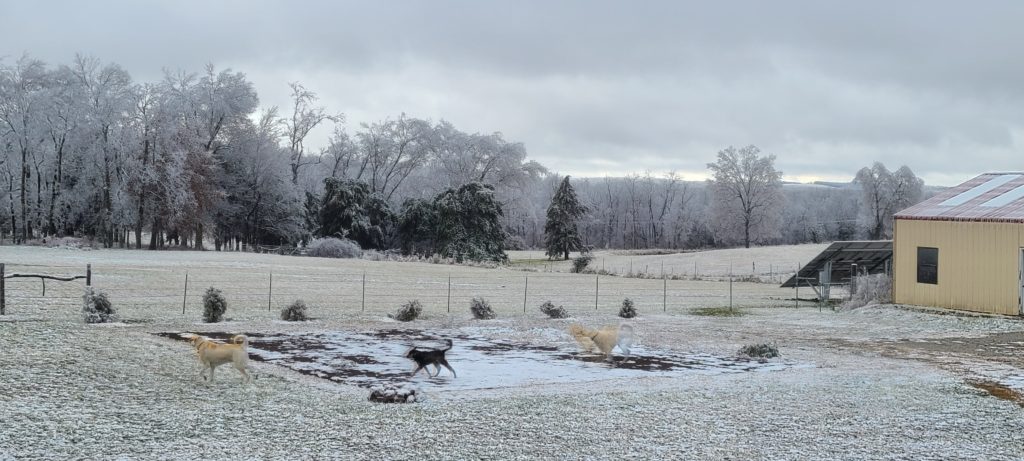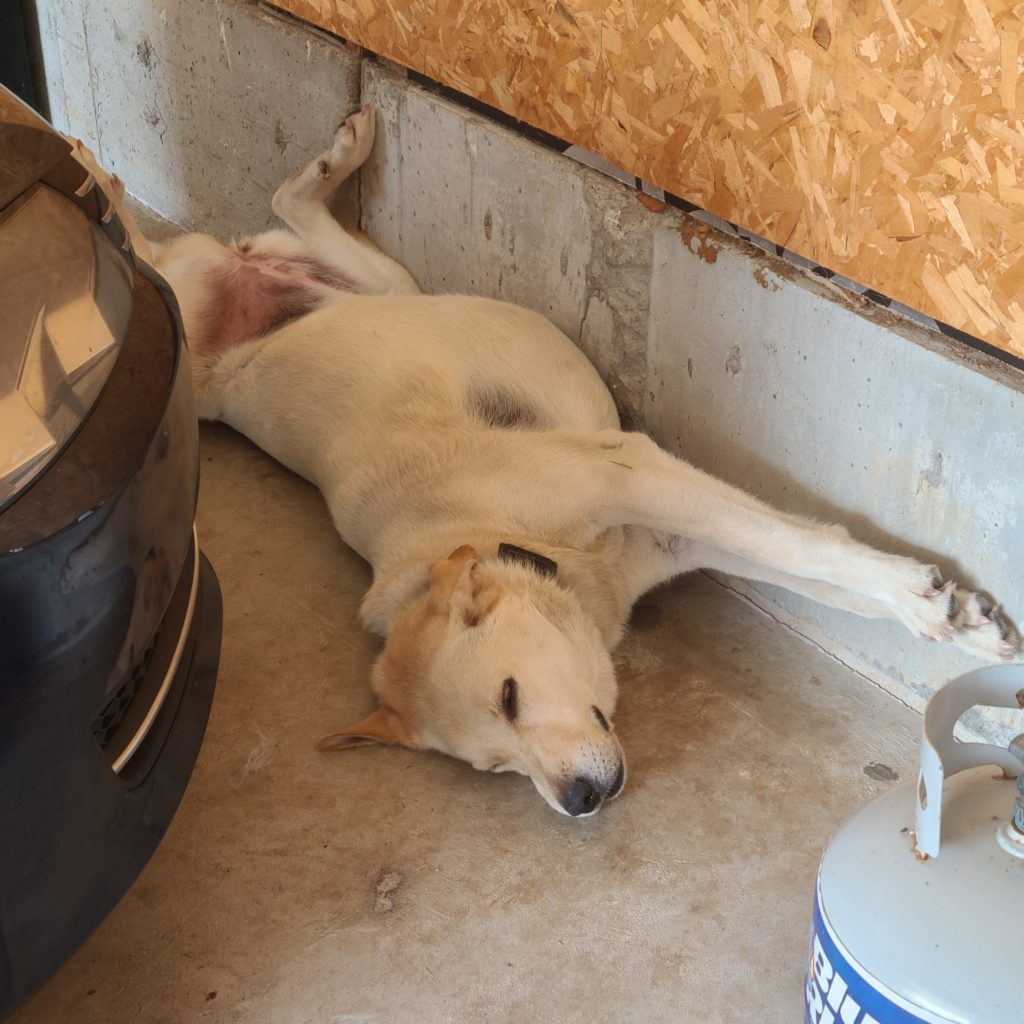We’ve spent a lot of time talking about how we travel, but it isn’t the only thing we do, so let’s shift gears for a minute. One of our most favorite things, and one of the things we most look forward to seeing when we get back to the acreage from traveling, are the four-legged DeBodes: Esma, Zara, and Jack, our livestock guard dogs.

We get lots of questions about our dogs, though most are directed at Esma and Zara. Most often people assume they’re some breed of Labrador, Retriever, or something similar and when we say this isn’t the case, we usually get confused looks. They might look like them but that’s where the similarities end.


Both Esma and Zara belong to a class of dogs known as Livestock Guardian Dogs (LGDs). When talking about LGDs, most folks are referring to the Anatolian Shepherd (AS), Great Pyrenees (GP), or Akbash breeds, though many other breeds are included. Probably the one you’ve heard of most often is the GP, but the others are becoming more common. While each has its own particular characteristics and personalities, they all are bred for a common purpose, as the name of their class would suggest: protecting livestock. We got ours to guard our flock of chickens against the coyotes, foxes, opossums, raccoons, and other four-legged critters with a taste for chicken, including other dogs.
These are not aggressive guard dogs like a German Shepherd, they have a much different demeanor. Specifically, LGDs typically are pretty laid-back, low-energy dogs. They are there as a deterrent to other animals, and this often stems from their imposing size (usually the dogs exceed 100 pounds and their heads will easily reach above your waist while they’re sitting – perfect for petting), excessive warning barking, and the fact that they often happily live with the animals they protect. While we mainly use them as a deterrent they WILL protect their charges to the death. In mountain areas, they are used in packs of 3+ to defend against wolves, bears, and big wildcats. We’ve seen evidence of this natural ability anytime another dog gets close to our property (except Jack, our stray Heeler – eye roll – they welcomed him right in) and from dead critters, we find in the yard after a particularly busy night.

But, while both Esma and Zara are LGDs, they are different breeds and because of that, they have somewhat different personalities. Esma is a pure-bred Akbash. She is the oldest of The Crew and has a very laid-back personality. In fact, she tends to be so laid-back that she’s the one we take cues from. It’s usually only when Esma gets upset about something that there’s actually something to worry about. Otherwise, she tends to roam our property throughout the day and night making sure all is well. When that isn’t happening, she’s usually sleeping in the sun in the winter or up against the cold concrete in the garage in the summer.

A mix between GP, AS, and Akbash, in many ways, Zara is everything Esma is not. Full of energy, loves chasing cars, barks at everything (and, more often, nothing), is always a mess, and loves the cold. Seriously, she sleeps in snowbanks whenever she can and whenever the temperature is above 50 degrees, she’s constantly in search of shade. Because she has so much energy and barks at everything, Zara is usually our first line of defense against the world; her barking and constant patrolling tend to keep other animals and people away. If that doesn’t work, her bark changes which tell Esma her assistance is needed. Once she arrives, things tend to calm down…or quickly escalate.

So, we have our dogs for a very specific purpose. Yes, they’re our pets. Yes, we love them. But they have a job, just like we do, and for them to be able to do their jobs, they need to be outside. This means our dogs are entirely outside dogs; none of them have ever stepped a paw in our house. I’m not sure we could even drag them in. The only exception is the garage; they’re always welcome to the garage to cool off (in the summer) or warm up (in the winter) as needed. But even then, most of them prefer to be outside where they can keep an eye on things. Sometimes we’ll catch one of them in the doghouse too with a head poked out, always watching.

We have lots of friends who have inside dogs, and in fact, even Jason grew up with inside dogs. So the concept of having a dog stay outside 100% of the time was a challenge for him. This was the case even though it makes sense that a dog who is supposed to watch and guard animals can’t do their job from inside the house. Still, there are a few things we want to clarify for all the folks who don’t like the idea of outside dogs.

First, our dogs have what’s called a dual-layer coat. This means they have longer hair that you can see and a shorter coat underneath. The shorter coat keeps regulates their body temperature throughout the year, while the longer hairs keep them clean; they also help with temperature regulation. This means they can be outside in very cold temperatures and be completely comfortable. Many times we’ve been out in the snow with the dogs, felt the dogs’ shorter coats and found they were warmer than we were with our multiple layers of clothes. This also explains why Zara is always in search of shade and sleeps in the snow.
Second, because our dogs have dual-layer coats, we aren’t supposed to cut their hair – ever. When you clip coats like theirs, you can often do more harm than good, especially if you don’t know what you’re doing. Why? Because cutting their hair incorrectly can mean it grows back abnormally. That means their coat won’t help regulate their body temperature anymore, which causes problems. That doesn’t mean we neglect them. Instead, it means we have to brush them, a lot, as soon as the temperatures start trending upward. So, don’t be surprised if you see clumps of hair all around our yard in the Spring and Summer. It’s just the dead hair the dogs would shed naturally, we’re just speeding up the process and giving the birds a hefty supply of nest-making materials.
Third, while our dogs live outside, that shouldn’t be taken to mean they have to stay outside. We have a barn that is entirely devoted to The Crew. They have shelter, plenty of straw to burrow in when it gets cold, beds, constantly-available water supplies (some heated), plenty of food, and so on. And, if it gets really cold, we have heat lamps we turn on to help them stay warm. However, Jack and the cats are really the only ones that utilize the heat lamps. Esma burrows in the straw in her den and Zara will sleep in a snow bank in the middle of the yard (we call her the winter pup). Also, as we said before, during the warmer parts of the year they stay close to the house, preferring to sleep on the cooler concrete while still being able to see everything. Most of the time in the winter you will find them up against the South side of the house soaking up the sun while still keeping an eye on everything.
Fourth, having outside dogs shouldn’t be taken to mean our dogs are either neglected or uncared for. All of The Crew get regular visits to the Vet (much to Zara’s dismay), are on all the medications they should be, eat food specifically formulated for larger dogs, and get loads of attention, pets, treats, brushing, and the like from us.

Just so we’re on the same page, we know there are people who mistreat their dogs. We also know that lots of times, this means they tie their dogs up, outside, for long periods of time, without the food/water/attention they need and deserve. We also agree with you that those people are the worst, shouldn’t have animals, and should probably be reported for what they do. However, please be careful about assuming that any dog left outside is being abused. There are plenty of legitimate reasons why they might be outside and we’d argue that we take better care of our outside dogs than some people do for their inside dogs.
Questions? Thoughts? Have furry members of your family you’re like to let us know about? Drop us a comment and let us know!
